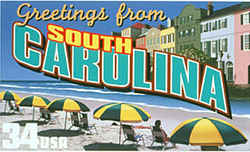
South Carolina Symbols
South Carolina State Snack Food
Boiled Peanuts
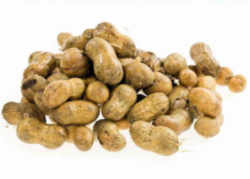
(Genus Arachis L.)
Adopted in 2006
Governor Mark Sanford signed House Bill No. 4585 (H4585) into law on May 1, 2006 making boiled peanuts the official state snack food of South Carolina.
Peanuts, goober peas, groundnuts - no matter what you call them, most South Carolinians agree they taste better boiled! Enjoyed year-round in the Palmetto State, boiled peanuts can be found everywhere from fairs and festivals to sporting events and roadside stands. In fact, they are such an important part of South Carolina culture that they were designated the official state snack in 2006:The General Assembly finds that boiled peanuts are a delicious and popular snack food that are found both in stores and roadside stands across the State, and this unique snack food is defined as peanuts that are immersed in boiling water for at least one hour while still in the shell. The General Assembly further finds that this truly Southern delicacy is worthy of designation as the official state snack food. (Act 270)
South Carolina State Snack Food: Boiled Peanuts
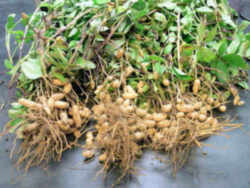
The peanut has long been a staple of South Carolina farms and plays an important role in our state's folk and cultural history. Some stories indicate
that boiling peanuts can be traced back to the Civil War, when Confederate soldiers used the legume as an important source of protein during food shortages.
As The Local Palate, a Charleston-based magazine, explains, "By boiling the peanuts in salted water, the Confederate troops were able to sanitize
the nuts, preserve them, and add much needed protein to their diet."
However, Becky Billingsley, a food historian from Myrtle Beach, explains that this legend is untrue. "During the Civil War there was a shortage
of salt," Becky writes, "so it is highly unlikely soldiers used it to boil peanuts. Also, boiling peanuts does not preserve them. In fact,
boiled peanuts quickly become slimy and inedible if they're not refrigerated or frozen, which would have been impossible for those soldiers."
Importantly, Becky adds that the real origin of boiled peanuts "can be traced back to African slaves. They were fed raw peanuts from their homeland
while on the slave ships coming to the United States, and then they grew them in their gardens by their slave cabins. They boiled peanuts among other
culinary preparations and introduced them to their masters' families."
The practice has continued through the years as generations of Southerners have shared this culinary genius. Boiled peanuts have become a South Carolina
tradition, and many local communities gather at harvest time to boil the surplus of farmers' unsold peanuts and share in a salty celebration! The South
Carolina Peanut Party, held annually in Pelion, is the most famous example.
Boiling your own peanuts is easy!
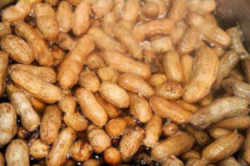 The most important
thing to remember is that you must use raw, unshelled peanuts - roasted peanuts cannot be boiled. Peanut purists say it's best to use "green"
peanuts, which are freshly harvested peanuts that have not been dried or dehydrated. Due to their high moisture content, green peanuts have a very
limited shelf life and are only available during the harvest season which runs May through November. Seasonal green peanuts can be found online, at
your local farmers' market, and even in some grocery stores. Dried raw peanuts can also be used, but require an overnight soaking and a much longer
boiling time.
The most important
thing to remember is that you must use raw, unshelled peanuts - roasted peanuts cannot be boiled. Peanut purists say it's best to use "green"
peanuts, which are freshly harvested peanuts that have not been dried or dehydrated. Due to their high moisture content, green peanuts have a very
limited shelf life and are only available during the harvest season which runs May through November. Seasonal green peanuts can be found online, at
your local farmers' market, and even in some grocery stores. Dried raw peanuts can also be used, but require an overnight soaking and a much longer
boiling time.
Boil Peanut Recipe
In a large stock pot, dissolve one cup of salt in two gallons of water; add the peanuts and bring to a boil. Cover the pot and maintain a low boil for 45 minutes. Check periodically to ensure that the water is covering the peanuts. Turn the heat off and carefully remove a peanut to sample, allowing it to cool first. If the peanut still crunches, return the pot to a boil. Boiled peanuts should be soft and mushy! Add more salt if desired. When the peanuts reach the desired consistency, turn off the heat and allow them to cool for an hour. When they're cool enough to handle, drain and serve.
Characteristics of the Peanut
The peanut (Arachis hypogaea) is a tropical plant that originated in South America. Peanut is a self-pollinating plant that looks like a yellow-flowered, low sweet pea bush growing slightly higher than 1 foot with a 3-foot spread. After the flowers wither, a flower stalk called a peg elongates and pushes the ovary or pistil of the flower into the soil to a depth of 1 or 2 inches. The pistil then develops into the pod containing the peanuts. At maturity the peanuts are harvested by lifting them out of the ground.
Growing Conditions
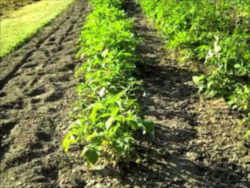
Boiling peanuts need at least 90 to 100 days to reach maturity. Dry peanuts need about 140 days to become fully mature in the Coastal Plain. Plant anytime between April and late June; however, planting after June 1 will not allow enough time for dry peanuts to reach maturity. The ideal time for planting peanuts is the first week of May when the soil is warm and moist. Germination is best between 68 and 95 ?F.
Plant seeds 2 to 3 inches deep in light textured sandy soils and 1? to 2 inches deep in clay soils. Sow five seeds per foot of row. Space the rows at least 20 inches apart. Twin rows spaced 7 inches apart on 36-inch centers will save space. Keep the soil moist after planting to ensure uniform germination.
Peanut Knowledge!
- In the South, boiled peanuts are often called "goobers" or "goober peas." Goober is the Gullah adaptation of "nguba" - the African word for peanut.
- Peanuts aren't nuts! They're actually part of the legume or bean family. Unlike other nuts, which grow on trees, peanuts actually begin as a ground flower. The weight of the flower forces it to mature under the soil - hence the name "groundnut."
- The smallest, most immature green peanuts are called "pops" and absorb the most salt during the boiling process. These have softer shells and are usually enjoyed whole!
- Goobers are good for ya! Boiled peanuts are a great source of vitamins and minerals, fiber, and antioxidants.
South Carolina House Bill No. 4585 (H4585)
(A270, R290, H4585)
AN ACT
TO AMEND THE CODE OF LAWS OF SOUTH CAROLINA, 1976, BY ADDING SECTION 1 1 682 SO AS TO DESIGNATE BOILED PEANUTS AS THE OFFICIAL STATE SNACK FOOD AND
TO PROVIDE THAT SCHOOLS ARE NOT REQUIRED OR ENCOURAGED TO SERVE PEANUTS, ESPECIALLY TO STUDENTS WITH FOOD ALLERGIES.
Be it enacted by the General Assembly of the State of South Carolina:
Findings
SECTION 1. The General Assembly finds that boiled peanuts are a delicious and popular snack food that are found both in stores and roadside stands
across the State, and this unique snack food is defined as peanuts that are immersed in boiling water for at least one hour while still in the shell.
The General Assembly further finds that this truly Southern delicacy is worthy of designation as the official state snack food.
Boiled peanuts, official state snack food
SECTION 2. Article 9, Chapter 1, Title 1 of the 1976 Code is amended by adding:
"Section 1 1 682. Boiled peanuts are the official state snack food. Nothing in this section requires or encourages any school district in this State
to serve peanuts to students, especially students with food allergies."
Time effective
SECTION 3. This act shall take effect upon approval by the Governor.
Ratified the 27th day of April, 2006.
Approved the 1st day of May, 2006.
South Carolina Law
The law designating boil peanuts as the official South Carolina state snack food is found in the South Carolina Code of Laws, title 1, chapter 1, article 9, section 1-1-682.
Title 1 - Administration of the Government
CHAPTER 1. GENERAL PROVISIONS
ARTICLE 9. STATE EMBLEMS, PLEDGE TO STATE FLAG, OFFICIAL OBSERVANCES
SECTION 1-1-682.
SECTION 1-1-682. Official state snack food.
Boiled peanuts are the official state snack food. Nothing in this section requires or encourages any school district in this State to serve peanuts
to students, especially students with food allergies.
Taxonomic Hierarchy: Peanut
Kingdom: Plantae - Plants
Subkingdom: Tracheobionta - Vascular plants
Superdivision: Spermatophyta - Seed plants
Division: Magnoliophyta - Flowering plants
Class: Magnoliopsida - Dicotyledons
Subclass: Rosidae
Order: Fabales
Family; Fabaceae â„ Leguminosae - Pea family
Genus: Arachis L. - peanut
Species: *

List Official US State Foods






